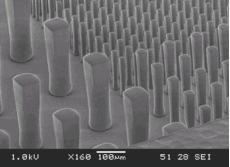Scientists at the University of Twente in the Netherlands have re-created one of nature’s most sensitive sound detectors – the hairs found on crickets, which allow them to detect small fluctuations in air currents and hear predators and make an escape before it’s too late. The breakthrough could lead to a new generation of cochlear implants, for people with severe hearing problems.
The team, led by Gijs Krijnen and Remco Wiegerink, built a mechanical array with several hundred artificial hairs. The sensors are made by depostiting thin layers of electrically insulating and conducting materials, creating structured electrodes on a suspended membrane. The structured electrodes form two capacitors with the underlying substrate.

Long hairs, made of a photo-structurable polymer, are put on top of the membranes. Airflow causes drag-forces on the hairs and so the membranes rotate, leading to a change in capacitance value of the capacitors.
Marcel Dijkstra, a member of the Twente team, said: “Their small size and low energy consumption make them excellent for application in large sensor networks, whereas there mechanical nature allows for mechanical filtering and parametric amplification. We could use them to visualise airflow on surfaces, such as an aircraft fuselage.”
In a more advanced stage, the structures may form a stepping-stone towards the fabrication of hairs operating in fluids, such as found in the inner ears of mammals.
The team are now producing newer generations of hairs, which they expect to deliver sensitivities at least one order of magnitude better than what has been presented in the paper.
Via Physorg.
